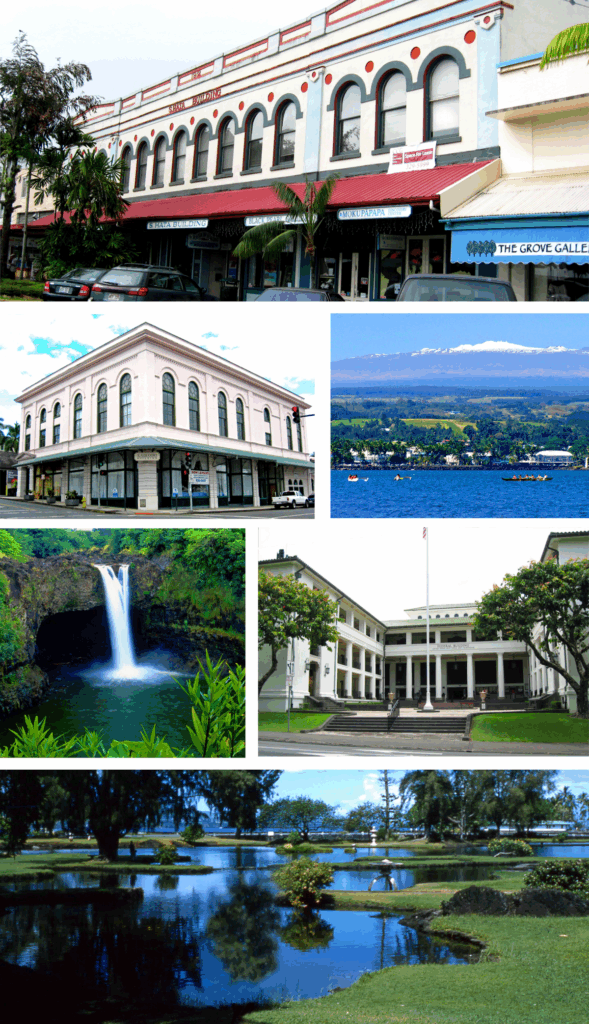
Moving to Hilo, Hawaii: A Comprehensive Relocation Guide
Considering moving to Hilo, Hawaii? This historic Big Island city offers tropical rainforest, authentic character, and affordable island living. With approximately 45,000 residents in 2025, Hilo combines small-city atmosphere with waterfalls and Hawaii’s most authentic and affordable town.
Demographic Profile to Consider If Moving to Hilo:
Hilo’s 2025 population is approximately 45,000 residents in this Hawaii County seat on the Big Island’s rainy east side. The median age is around 40 years, with diverse residents including Native Hawaiians, local families, students, and transplants. The population is approximately 28% Asian, 26% Two or More Races, 24% White, 17% Native Hawaiian and Pacific Islander, 3% Hispanic. Hilo features historic downtown with preserved buildings, the University of Hawaii at Hilo campus, residential neighborhoods, and tropical rainforest surroundings. The wettest city in America receives 130+ inches of rain annually creating lush greenery. Hilo maintains authentic local character without resort development. The city attracts those seeking real Hawaii, affordability, and community atmosphere. Hilo values Hawaiian culture, education, environmental awareness, and preserving authentic island character. Find trusted local services for moving, living, and working in Hilo.Hilo Relocation Directory
Cost of Living to Consider If Moving to Hilo:
Hilo offers Hawaii’s most affordable housing. Median home values range from $450,000 to $600,000 in 2025, significantly lower than other Hawaiian cities while providing island lifestyle. The median household income is approximately $62,000. Rental properties average $1,800 to $2,600 monthly. Hawaii has high excise tax (4.5%). Overall cost of living is high with expensive groceries (50-70% above mainland), costly gas, and high utilities, but Hilo provides the most affordable Hawaii option. The rain limits resort development keeping prices lower. Housing costs create relative accessibility for Hawaii while maintaining island living. The trade-off is frequent rain versus sunshine coasts. Many accept the weather for affordability and authenticity.
Economy and Job Market:
Hilo’s economy includes government, education, healthcare, tourism, and agriculture. Hawaii County government provides significant employment as the county seat. The University of Hawaii at Hilo employs faculty and staff. Hilo Medical Center offers healthcare jobs. Tourism supports hotels, restaurants, and services though on smaller scale than Kona. The Port of Hilo handles cargo. Retail serves the east side population. Agriculture including papaya, macadamia nuts, and diversified farming continues. Many residents work multiple jobs. Some work remotely. Typical industries include government, education, healthcare, agriculture, and tourism. The economy operates at island pace with steady government and education providing stability.
Education:
Hawaii Department of Education operates Hilo schools including Hilo High School and numerous elementary and intermediate schools. School quality varies. The University of Hawaii at Hilo offers four-year programs emphasizing Hawaiian studies, astronomy, marine science, and agriculture creating college-town atmosphere. Hawaii Community College provides workforce training. Private schools serve some families. The educational infrastructure reflects authentic Hawaii with emphasis on Hawaiian culture and environmental science.
Recreation and Lifestyle:
Hilo offers spectacular natural beauty including Rainbow Falls, Akaka Falls State Park (442-foot waterfall), tropical beaches including Richardson Beach and Carlsmith Beach (though swimming limited by cooler water), Liliuokalani Gardens (Japanese gardens), Panaewa Rainforest Zoo, and proximity to Hawaii Volcanoes National Park (45 minutes). The historic downtown features farmers market (renowned across Hawaii), shops, and restaurants. Residents enjoy the rainy tropical environment creating lush landscapes. The Merrie Monarch Festival celebrates Hawaiian culture with world-renowned hula competition. Mauna Kea summit access provides stargazing. The lifestyle emphasizes ohana (family), respect for Hawaiian culture, acceptance of rain, and authentic island living. The tropical climate means warm temperatures year-round with frequent rain. The community values authenticity, Hawaiian traditions, environmental stewardship, and rejecting mainland commercialization. Living in Hilo means embracing rain (serious rain—bring umbrellas always), prioritizing community over amenities, and choosing authenticity over resort life. The frequent rain creates trade-offs but maintains affordability and authentic character.
Healthcare and Services:
Hilo residents access healthcare through Hilo Medical Center providing comprehensive services as the Big Island’s largest hospital. The medical center serves the east side and island with emergency services. Specialized care requiring travel to Honolulu is sometimes necessary. The healthcare infrastructure serves the community adequately for most needs.
Transportation:
Hilo International Airport (ITO) provides interisland flights and limited mainland service. Hele-On Bus operates limited routes in Hilo and to other Big Island communities. Most residents require personal vehicles. Downtown Hilo offers some walkability. Gas is expensive. Typical travel times within Hilo are short. Driving to Kona takes 2+ hours.
Conclusion:
Moving to Hilo in 2025 offers authentic Hawaii living with tropical rainforest, waterfalls, and affordable island lifestyle. The city’s combination of frequent rain, Rainbow Falls beauty, and real local character makes it ideal for those seeking genuine Hawaii where affordability meets authenticity and daily rain showers water paradise’s most authentic and welcoming community on the Big Island’s lush rainforest coast.

